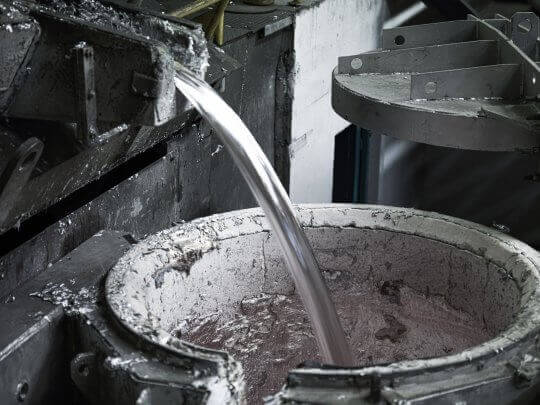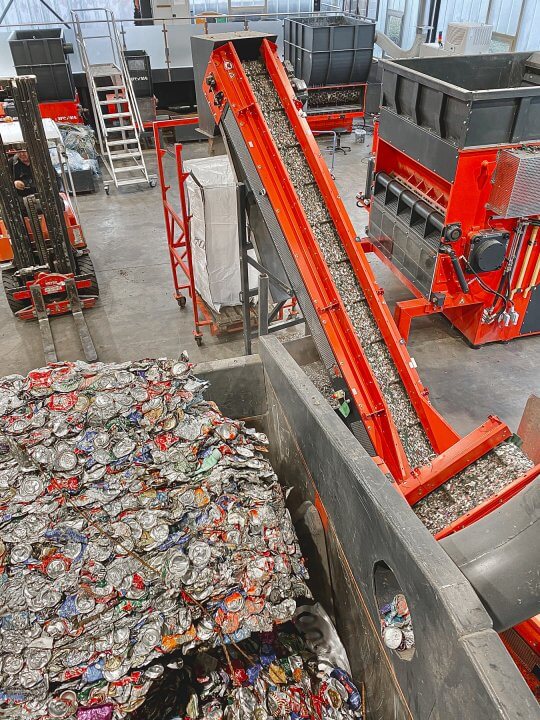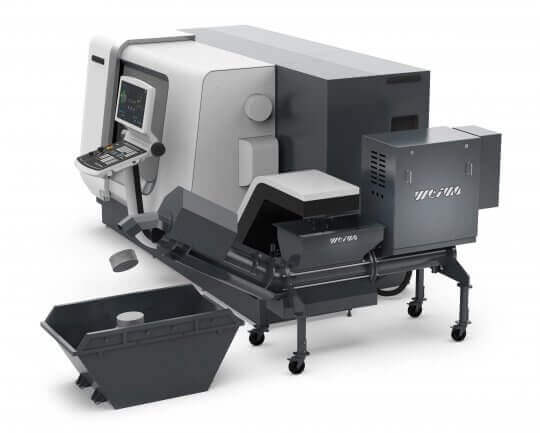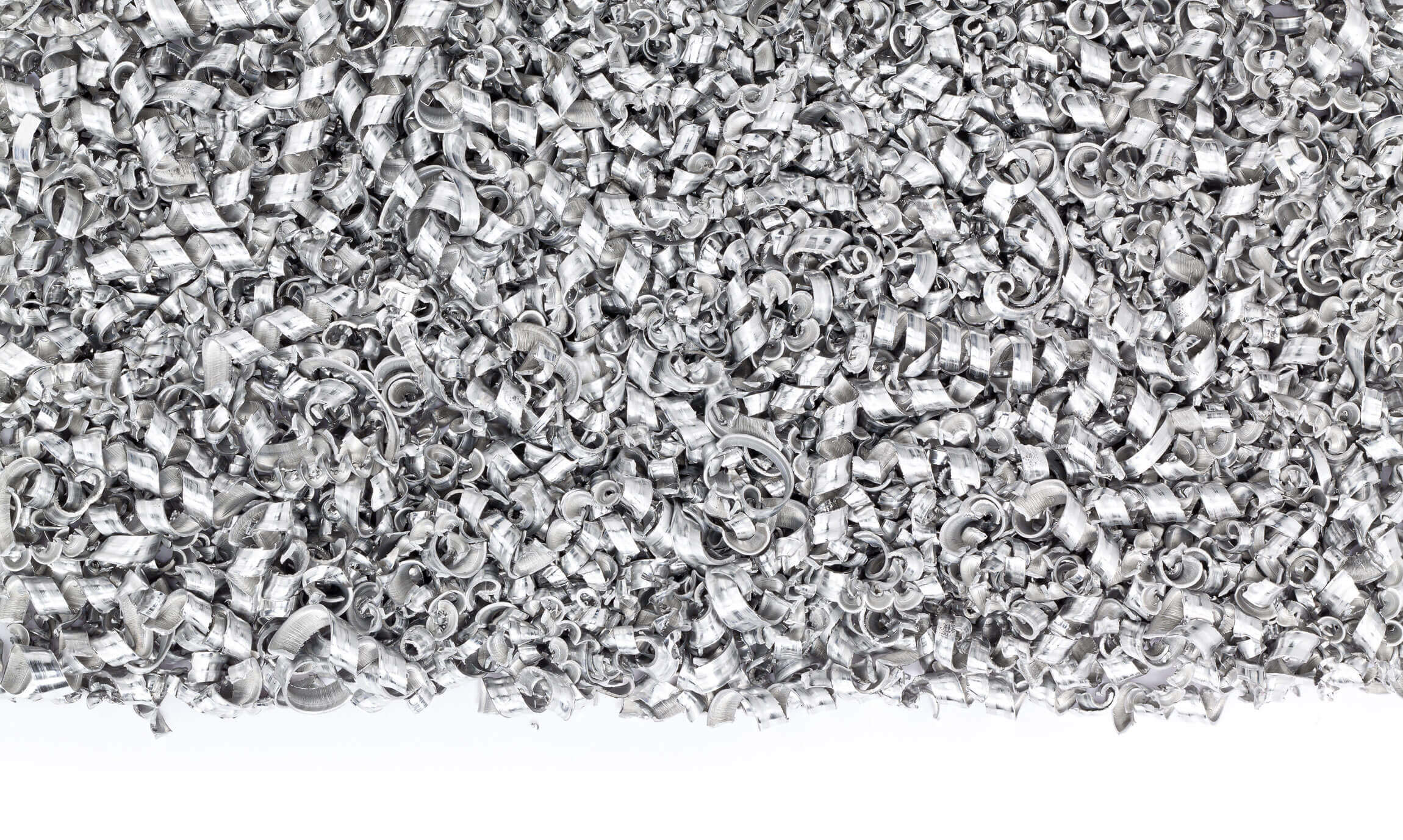
Aluminum Chips Processing, Shredding, Briquetting and Recycling
Information on reclaiming and disposing of aluminum milling waste from the metals industry
No other metal is more common in our earth’s crust than aluminum. Valued for its comparatively low weight, the matt-finished light alloy was recognized early on for numerous applications, such as in industry, transportation, logistics and packaging. Aluminum as a raw material plays a further pioneering role in recycling: It can be terrifically recycled. The quotas for secondary aluminum can certainly still be expanded but are already at a decent level compared to many other waste streams. In addition to the processing of aluminum cans, foils, scrap or profiles, the issue of aluminum chips (swarf) and their recycling will be examined in greater detail on this page. Companies that process aluminum have an opportunity to find out here about the professional processing of aluminum waste from sawing, turning or milling by means of shredding, briquetting, drainage and compaction.
Practical examples and references: aluminum recycling
The aluminum recycling process has not only been technically mature for many years but is also extremely economical for companies and for ecological reasons. These and many other customers successfully process their aluminum chips themselves on site:
thyssenkrupp (see video)
Volvo Powertrain
Saab Aeronautics
Ljunghäll
Ball Aerocan
AERO VODOCHODY
How is aluminum used as a raw material?
Aluminum light alloy has always been very popular because of its properties. It is lightweight, easy to apply and has a low density as well as high tensile strength as an alloy. Thanks to its elasticity, aluminum can even be used to make foil. All of this contributes to a steady growth in global demand. Electromobility (e.g., battery housings, lightweight vehicle bodies) and the expansion of renewable energies by wind turbines will further enhance this trend in the near future. For this reason, classic aluminum production based on ores will not be sufficient in the medium term to cover the enormous demand.
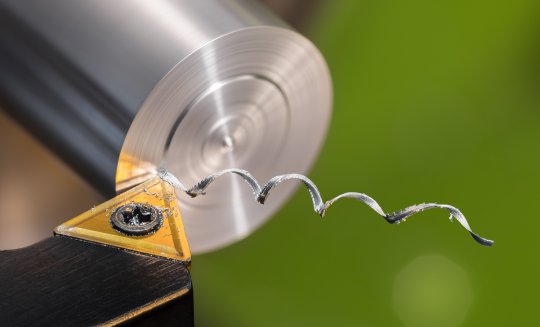
Aluminum turning
Primary aluminum: bauxite mining for aluminum production
More than 1.1 million metric tons of aluminum are produced in Germany every year (Source: Umweltbundesamt). A little over half of this comes from secondary materials – the other major part still comes from ore. The reddish mineral bauxite is first extracted in aluminum smelters to produce aluminum oxide before fused salt electrolysis produces pure aluminum.

Bauxit stone
Did you know?
1. Since 1980, aluminum production has quadrupled worldwide – from 5 to 20 million metric tons.
2. Japan has not produced any primary aluminum since 1980.
3. The recycling rate for cans in Europe is on average 70%.
How is aluminum recycled? (Secondary aluminum)
The multiple recycling of aluminum is significantly less energy-intensive (only about 5 percent) than the expensive production of new primary aluminum. In addition, the loss of quality is very low. The fact that aluminum is virtually completely recyclable makes this raw material a real resource for the circular economy. Aluminum scrap or waste is first collected and then prepared for remelting by shredding and compaction. Compared to many other metals, aluminum has a relatively low melting point – namely at approx. 660°C. This facilitates processing in large drum furnaces. Afterwards, the liquid metal is usually further processed in foundries. Consequently, the aluminum cycle starts and ends with melting. Worldwide, the recycling rate of aluminum is estimated at approx. 40 percent.
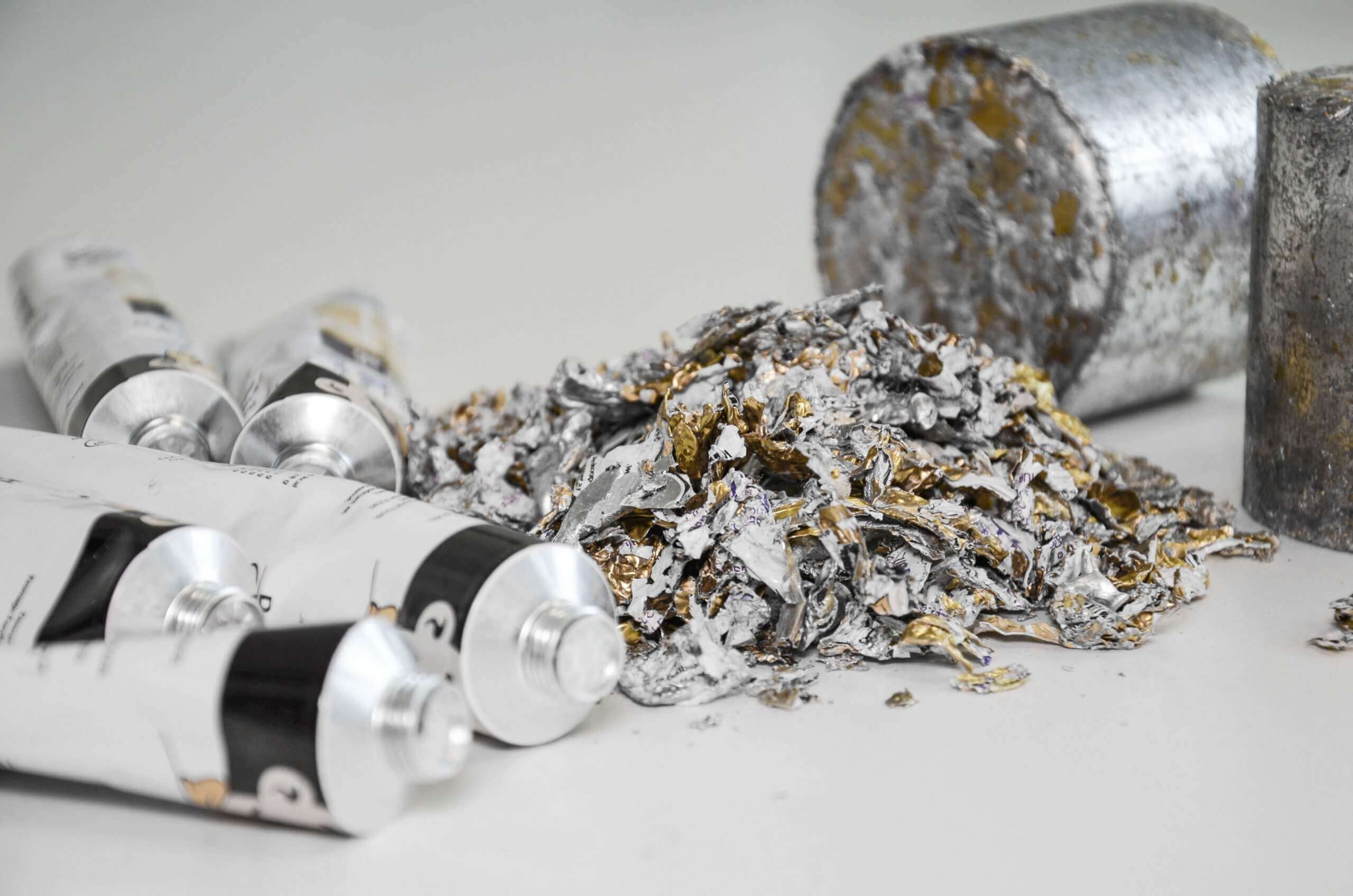
Aluminum tubes shredded and briquetted
Dross in the production of secondary aluminum
It may sound strange, but it’s a completely normal phenomenon in industrial aluminum recycling: so-called dross. The waste products that accrue from melting aluminum in drum furnaces consist of aluminum, aluminum oxide, aluminum nitride and salts such as chlorides and fluorides. They float on the surface of the very hot metal bath. The dross is regularly skimmed off so that no impurities enter the subsequent casting. In order to also recover pure aluminum from the dross, the residues mentioned (oxides, nitrides, salts) must be removed.
To minimize dross caused by burn-off, it helps to introduce as little loose material as possible (such as chips). Significantly better melting can be produced using aluminum briquettes, which consist of firmly pressed aluminum chips and which do not float on the surface.
Source: Maschinenbau-Wissen
<a href="Source: Bundesforschungszentrum für Wald
Where do most aluminum residuals and production waste come from?
- Vehicle construction (bodies, engines, wheel rims)
- Packaging (cans, foils, trays, containers)
- Building and construction industry (facades, roofs)
- CNC metal processing (waste from sawing, turning, milling)
- Electrical engineering (housings, cables, electrical devices, heat sinks)
Source: Wirtschaftsvereinigung Metalle
Aluminum chips are not only produced in machining operations. Chips are also a regular waste product in melting, rolling and pressing plants when processing cast primary or secondary aluminum.
What aluminum waste products are suitable for recycling?
All too often it is forgotten that not only typical everyday items such as plastic bottles, magazines, yogurt cups or shampoo bottles can be recycled. Metals are also highly recyclable. Aluminum in particular is ideal for recycling, as it largely retains its characteristic material properties even after recycling.
The highest secondary aluminum quality is achieved with material streams that are as pure as possible. This includes, for example, aluminum process scrap (production waste). In most cases, little to no alloys are present and the aluminum has not yet been used. Magnesium in particular repeatedly leads to downcycling during the processing of aluminum scrap.
Metalworking and processing companies also produce enormous quantities of aluminum waste in the form of chips on a daily basis. They come from machining during milling, turning or sawing. The mostly voluminous aluminum chips are typically collected in metal tipping containers next to a CNC machine before the chips are further processed or disposed of. In the best case scenario, the material is then shredded and compacted (via briquetting or compressing). This reduces the volume of waste and increases the sales value of the aluminum scrap.
Another source of aluminum is post-consumer scrap. These metals/products have already gone through their life cycle. This includes aluminum cans and aluminum foil as well as items such as aluminum profiles, uncut bar stock lengths or windows that are being replaced. Once again, the biggest challenge is to produce the highest possible quality recycled aluminum. As soon as material is contaminated, anodized, alloyed or coated with paint, an additional process step is required for recycling. And that requires time and energy.
What kinds and types of (metal) chips exist?
The good news first: WEIMA machines are able to process almost any type of chip – large, small, spiral or wool-like. Machining processes (such as turning, milling, drilling, sawing) produce metal parts that are mechanically removed. Different cutting geometries, the cutting speed and the particular material cause chips to occur in different shapes.
So-called discontinuous chips are often found in brass machining – generally with brittle materials. This is due to relatively small cutting angles and low process speeds.
Continuous chips, on the other hand, are caused by strong deformation in the area where mechanical energy is applied.
A similar deformation occurs with a flow chip. However, this deformation takes place much more uniformly in the material layers. Particularly when turning or drilling, the high cutting speeds create the characteristically long and curled chips, which combine to form voluminous wads. If the lamellae of a flow chip are particularly pronounced, this is referred to as a lamella chip.

Spiral metal shavings
Aluminum chips: high volume, low weight
Typical process steps in the aluminum cycle include: machining, shredding, compaction, melting
The briquetting of metal waste (e.g., aluminium chips) from machining offers numerous advantages. Unfortunately, many aluminum processors know the problem of overflowing containers and high manual disposal costs only too well. Emptying containers takes time and doesn't generate any money.
A significant volume reduction is possible by means of compaction. Large wads, consisting of milling waste from the last layer, are a thing of the past. At the same time, you can recover valuable coolant or lubricant through compression and can feed it back into the recycling cycle. The result: high-density aluminum briquettes (round or square), which melt better during recycling, are almost dry and therefore generate higher revenue for the recycler.
Increase the yield and cost-effectiveness of your aluminum residues with system solutions from WEIMA.
Advantages of aluminum metal chip briquetting
- Significant waste volume reduction of up to 90%
- Minimized storage, handling and transportation costs
- Recovery of expensive coolants, oil and emulsion
- Better melting behavior compared to loose chips (less burning and oxide formation)
- Higher yield in the melting process with a remelter or refiner
- Low residual moisture, no centrifuge required for drying
- Higher density of aluminum briquettes compared to loose chips
Pressing aluminum chips with WEIMA TH 800 M Briquetting Press
We recommend TH Industrial series briquette presses for ambitious metal applications. The TH 800 M shown in the video has a drip tray with pump for the pressed-out emulsion. The produced aluminum briquettes have a diameter of 80 mm and are ideal for subsequent aluminum recycling.
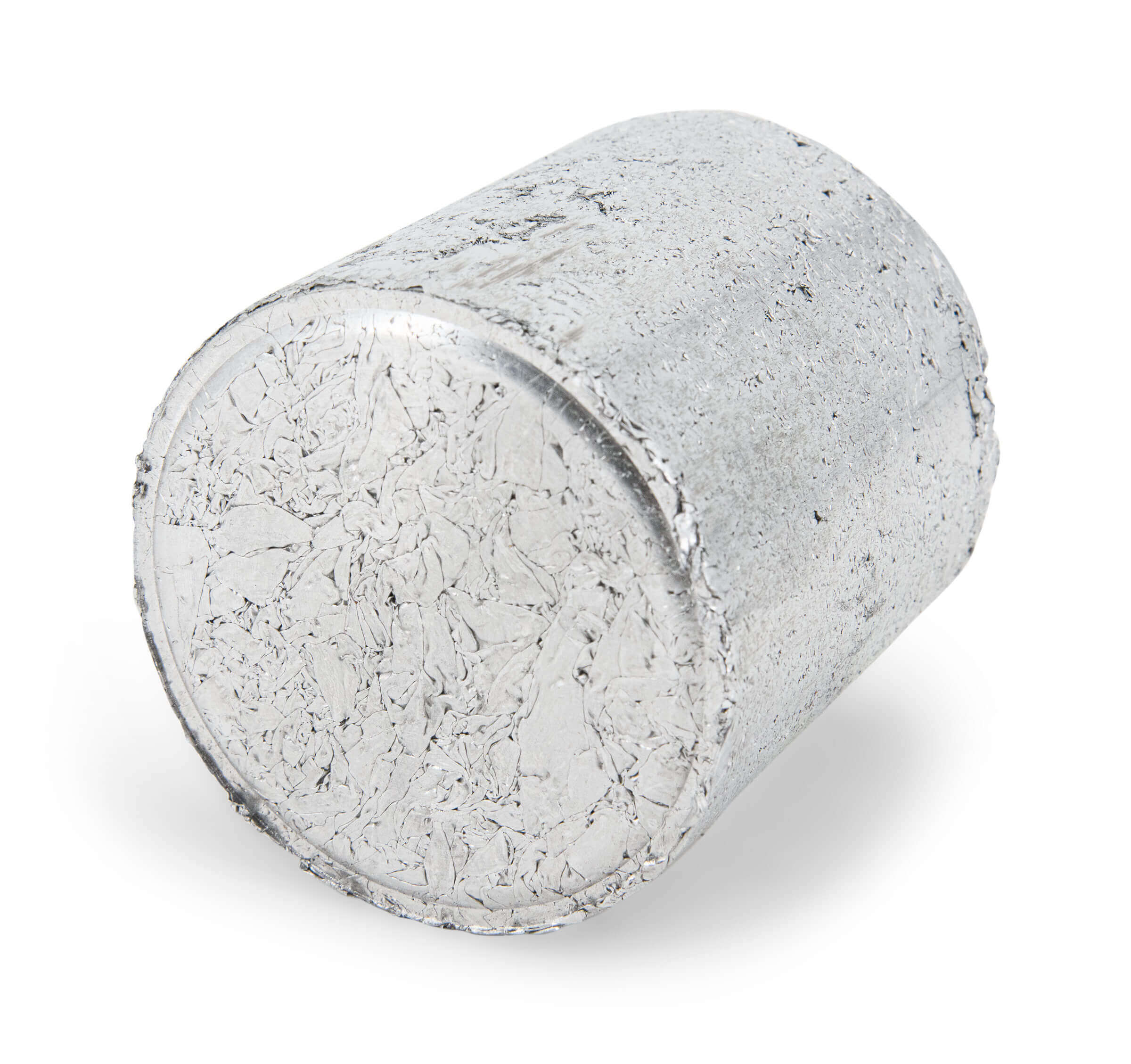
80 mm briquette made of aluminum chips
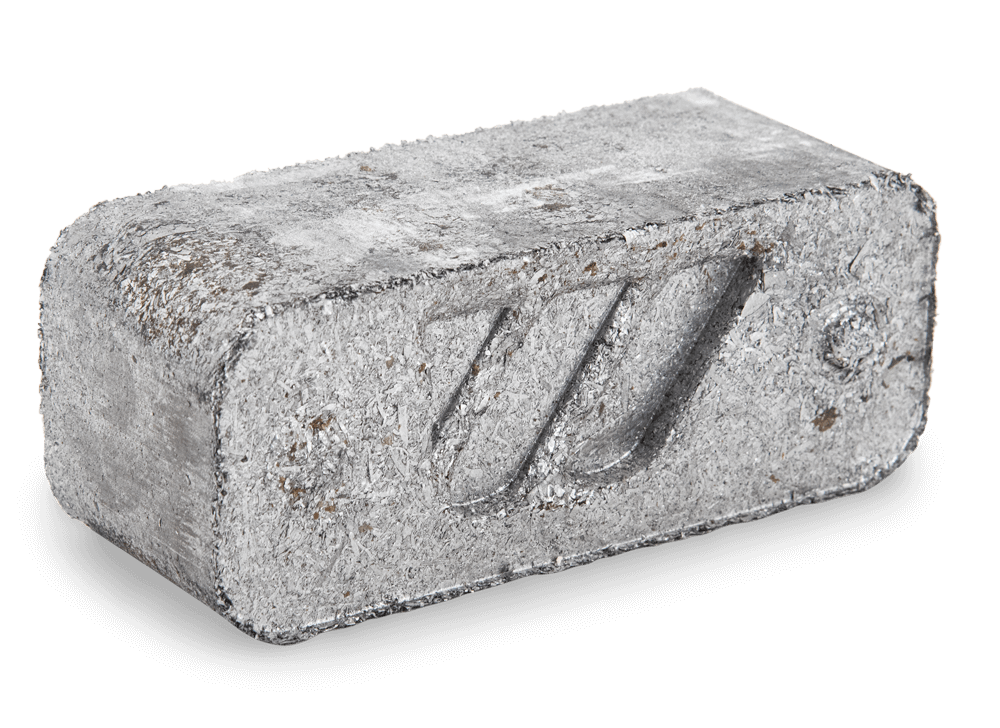
Shredded aluminum swarf briquette
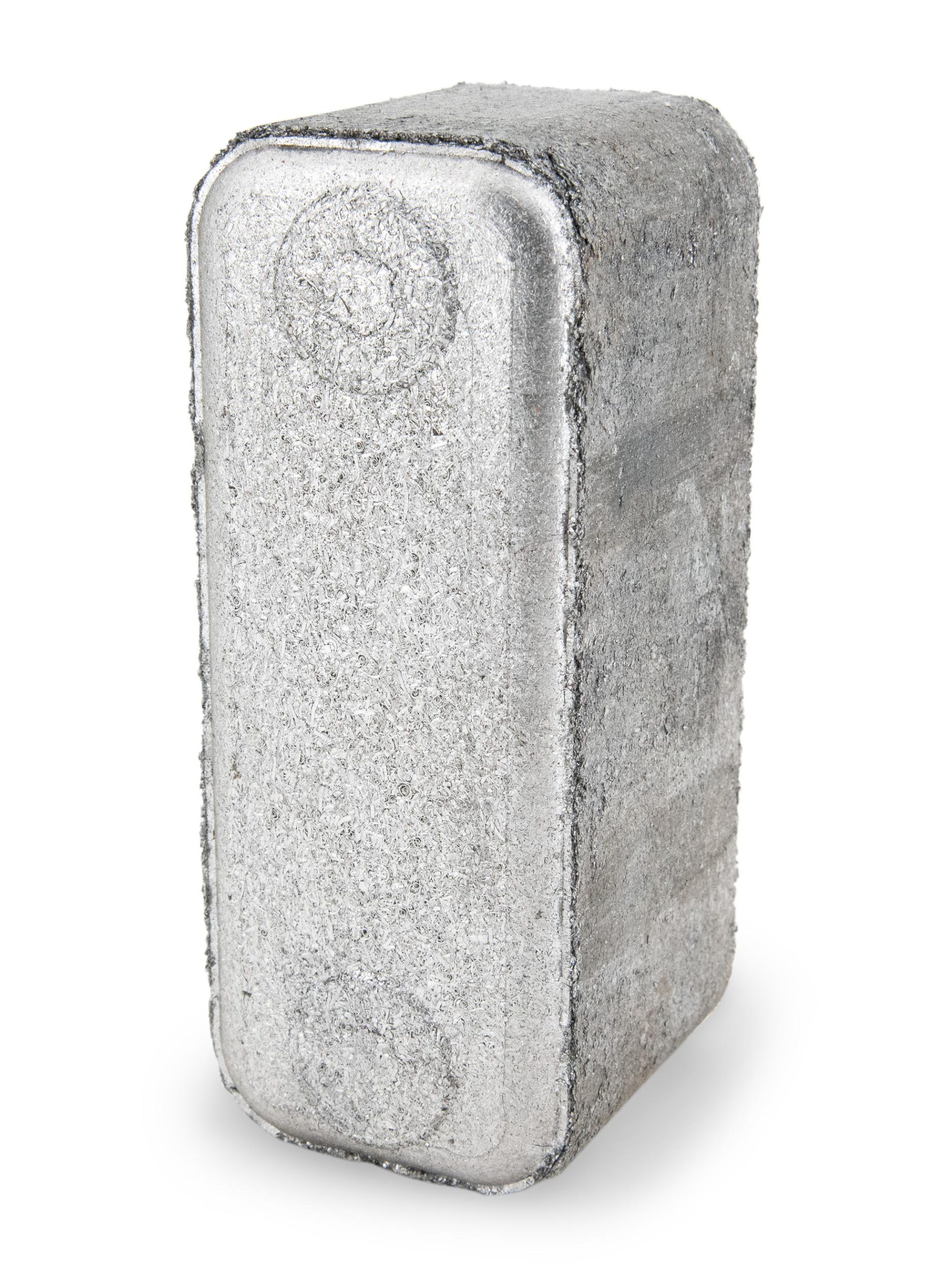
Briquette of compacted aluminum shavings
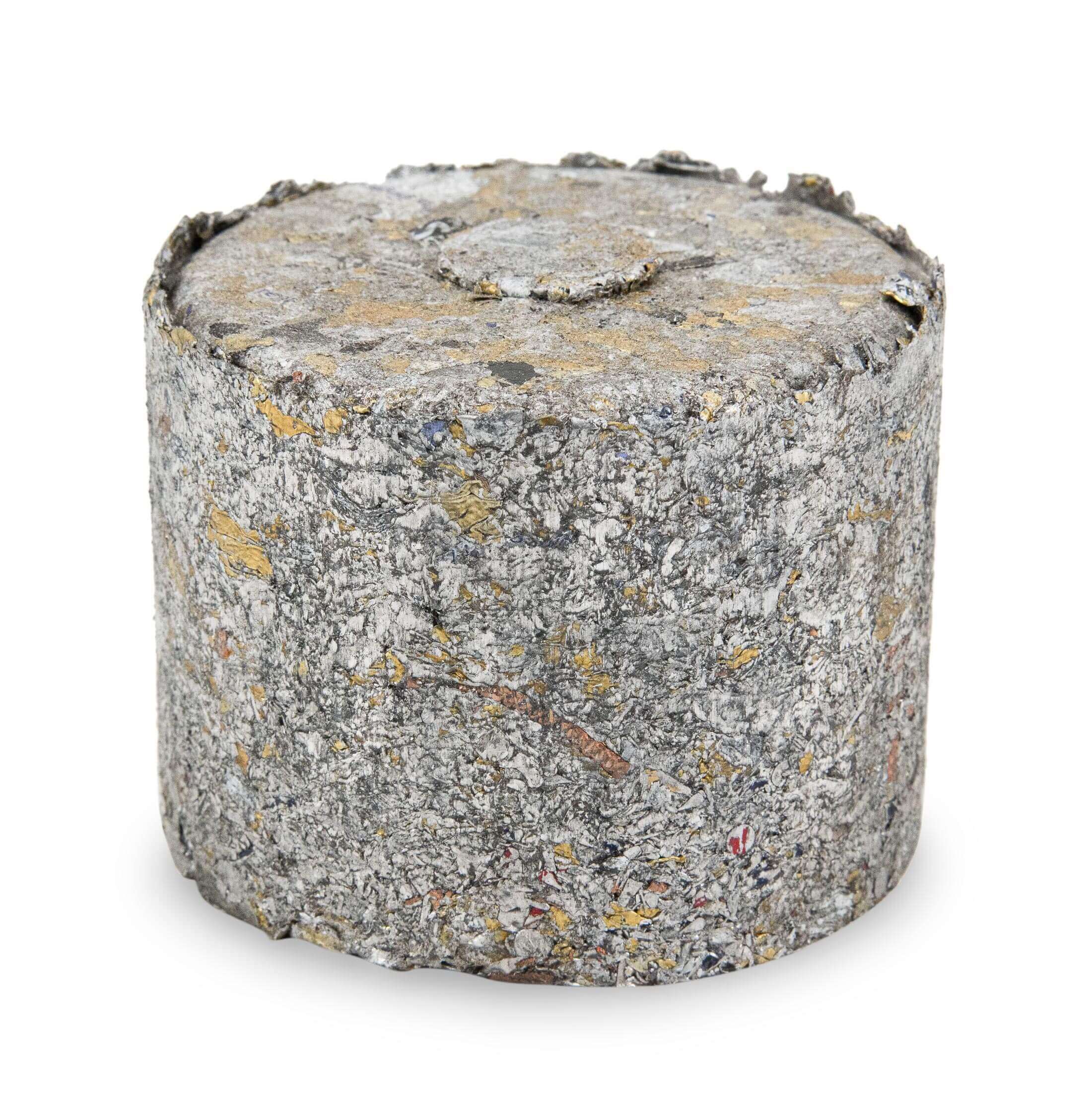
Briquetted aluminum cans
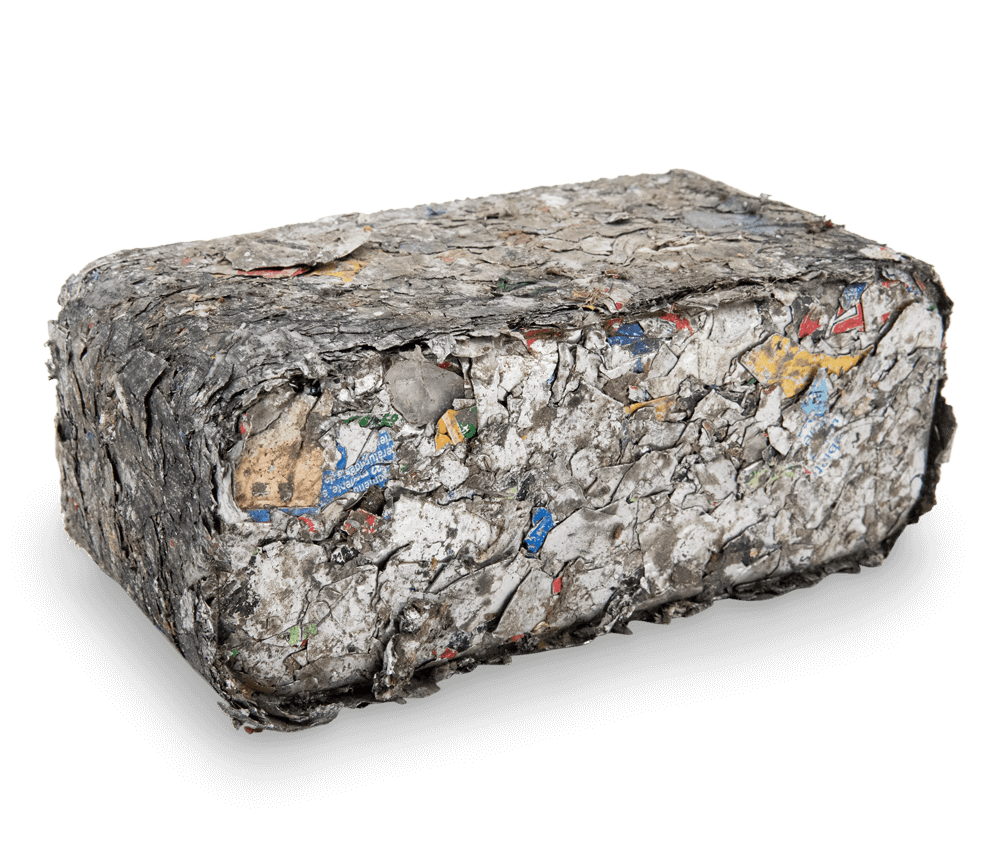
High-density briquette made of aluminum packaging
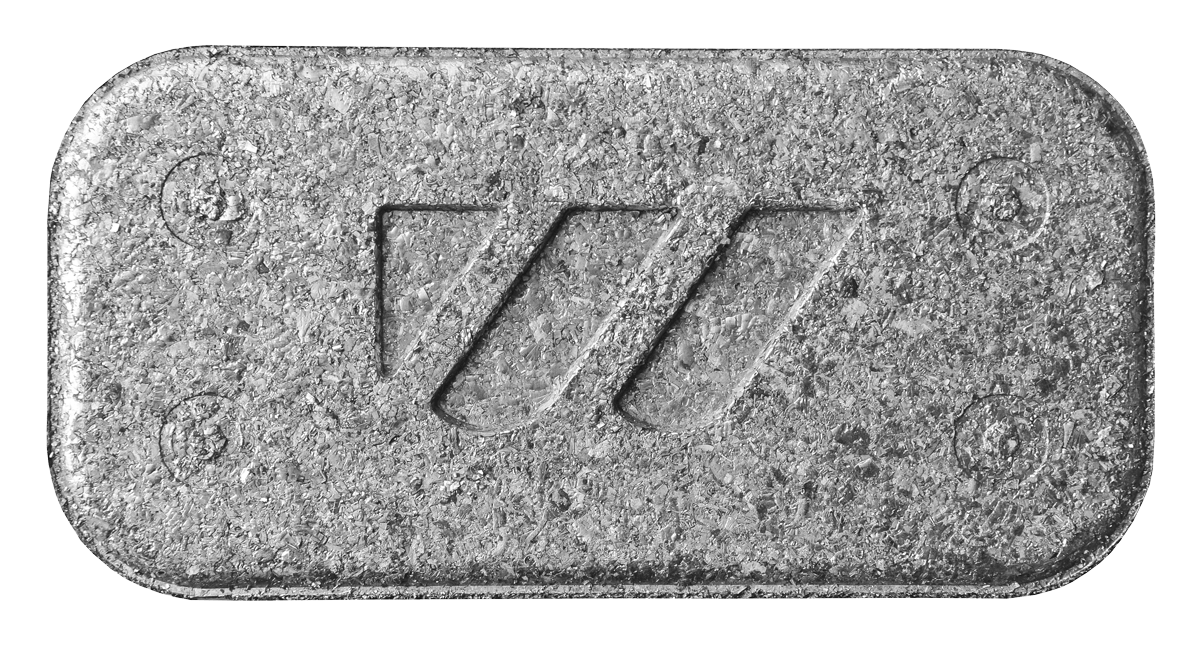
Branded aluminum briquette
Good to know!
Around 75% of the aluminum produced since 1888 is still in use.
Compacting loose aluminum chips with a WEIMA Chip Press
Process your aluminum chips from turning, milling or sawing where they are produced: right next to the machine. A WEIMA press can be placed beneath the chip conveyor (discharge) and compress waste into easy to handle briquettes with a diameter of 200 mm. This saves transportation expense and manual handling. At the same time, you can drain your chips and thus save weight during disposal. If required, the recovered coolant can be returned to the recycling cycle.
Aluminum can recycling success story at the Oettinger brewery
Hardly any packaging achieves recycling rates like the popular beverage can. The recycling of aluminum cans is sustainable and also particularly efficient technically. With the help of WEIMA machines, you can shred, briquette or compact cans into palm-sized briquettes. Whether large, small, filled or unfilled – we offer the right disposal solution. Find out in the following video how the popular beer brewer Oettinger drains and compresses its production waste in a practical way.
Worth knowing.
In Germany, 126 of 135 kilo-tons of aluminum packaging is recycled. That’s over 93%. For comparison: In 1991, this figure was barely 18%.
Request a shredder, briquetting press or liquid drainer for aluminium chips now
Request a quote
WL 4: Compact and robust single-shaft shredder for aluminum waste
With thousands of machines on the market, the popular WL 4 Shredder is one of WEIMA's best-sellers. Valued for its robust construction and low-maintenance operation, it is ideal for aluminum recycling, especially with added options for metal shredding. It shreds long chips to a uniform chip size. This is ideal for downstream briquetting.

View inside WEIMA WL 4 shredder
Learn more: metal shredding
Learn more: metal briquetting
Learn more: aluminum can compaction
TH Industrial series: Briquetting presses for the highest demands
For reliable and economical volume reduction of aluminum chips: The TH series (including the TH 600 M, TH 800 M, TH 1500) from WEIMA was specially designed for industrial applications and compresses all compressible materials in one mold. The resulting briquette is very dimensionally stable and is ejected alternatingly. The motion sequences of the cylinders and the mold are monitored and controlled by a path measurement system.

TH 800 M (left) and TH 1500 (right)
WLK 1000: for high throughputs when shredding aluminum chips
With a working width of 1,000 mm, the shredder can easily pick up and shred even voluminous bundles of chips. The desired chip size is defined by a perforated screen mounted below the rotor.
A powerful electromechanical drive together with a WEIMA WAP transmission ensures maximum output power for industrial operation.

WEIMA WLK 1000 single-shaft shredder
WEIMA C.200: chip press for draining and compaction
The C.200 turns voluminous chip heaps into compact compressed tablets. The machine compacts and drains aluminum chips from CNC machining centers using a hydraulically movable press cylinder. This saves time and costs and reduces disposal expenses. One less thing to worry about.

WEIMA PUEHLER C.200 chip press
Available only at WEIMA
Heavy-duty machine designs
for long service life
Easy maintenance
for minimum downtimes
Many drive options
for maximum throughput
Fast service
for highest customer satisfaction
Everything from a single source:
Machines, material handling technology, metal detection, support, spare and wear parts for tailor-made solutions
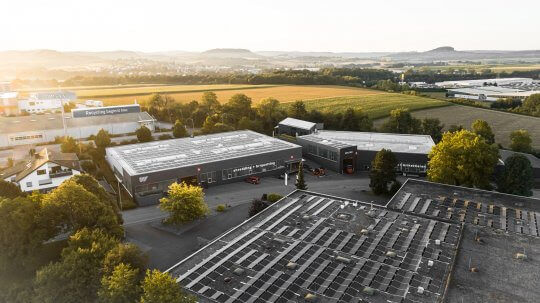
WEIMA headquarters Ilsfeld (Germany)
See for yourself
The WEIMA showroom is equipped with shredding and briquetting machines of all sizes and technologies. This enables us to simulate your application as realistically as possible. You have the possibility to send us your material or visit us directly in Fort Mill. From our gallery you have the best view directly into the cutting chamber. So you can observe the shredding process live.
Request an appointment now
Alternatively you can send us material for testing.
Click here for the form.

Aluminum can shredding with WEIMA W5.18
